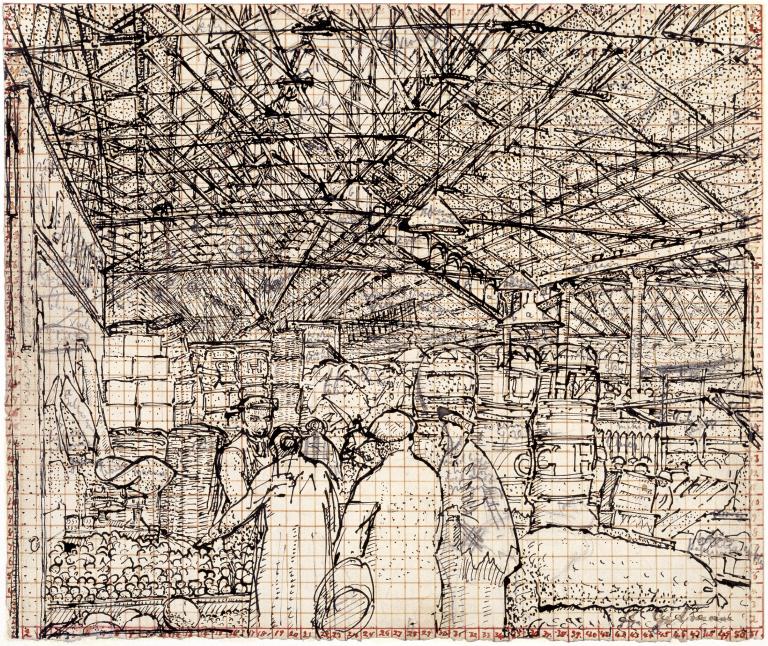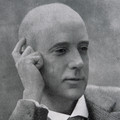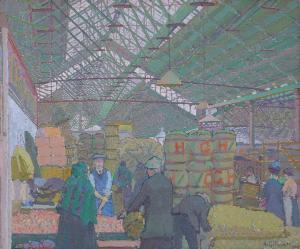Harold Gilman Study for 'Leeds Market' c.1913
Harold Gilman,
Study for 'Leeds Market'
c.1913
Harold Gilman’s finished oil painting, Leeds Market (Tate N04373), follows the composition of this pen and ink drawing aside from small adjustments to the figures in the foreground. This study reveals Gilman’s close attention to the intricate architecture of the roof; on the reverse, handwritten notes describe the girders and beams with the light filtering through.
Harold Gilman 1876–1919
Study for ‘Leeds Market’
c.1913
Ink and graphite on paper
250 x 297 mm
Inscribed ‘H. Gilman’ bottom right
Purchased from Leger Galleries, London, (Grant-in-Aid) 1957
T00143
c.1913
Ink and graphite on paper
250 x 297 mm
Inscribed ‘H. Gilman’ bottom right
Purchased from Leger Galleries, London, (Grant-in-Aid) 1957
T00143
Ownership history
Purchased from the artist in 1916 by Sir Louis Fergusson (1878–1962), from whom bought in 1956 by Leger Galleries, London, from whom bought by Tate Gallery 1957.
Exhibition history
1948
The Collection of Sir Louis Fergusson, K.C.V.O., Leicester Galleries, London, September 1948 (14, as ‘Leeds Market Study for the Painting in the Tate Gallery’).
1961–2
Drawings of the Camden Town Group: An Exhibition to mark the Fiftieth Anniversary of the Founding of the Group in 1911, (Arts Council tour), Bradford Art Gallery and Museum, October 1961, Southampton City Art Gallery, November 1961, National Museum of Wales, Cardiff, December 1961, Birmingham City Museum and Art Gallery, January 1962, Arts Council Gallery, London, February–March 1962, Manchester City Art Gallery, March–April 1962 (23).
1981–2
Harold Gilman 1876–1919, (Arts Council tour), City Museum and Art Gallery, Stoke-on-Trent, October–November 1981, York City Art Gallery, November 1981–January 1982, Birmingham Museum and Art Gallery, January–February 1982, Royal Academy of Arts, London, February–April 1982 (62).
1992–3
Beardsley to Bomberg: British Drawings and Watercolours 1870–1920, Tate Gallery, London, November 1992–February 1993 (no number).
2002
Harold Gilman and William Ratcliffe, Southampton City Art Gallery, April–July 2002 (no number).
.
References
1946
R.A. Bevan, ‘The Pen Drawings of Harold Gilman’, Alphabet and Image, December 1946, p.53.
1950
Maurice de Sausmarez, ‘Camden Town Group Pictures in the Leeds Collection’, Leeds Art Calendar, Spring 1950, p.18.
1958
Tate Gallery Report 1957–58, London 1958, p.14.
1964
Mary Chamot, Dennis Farr and Martin Butlin, Tate Gallery Catalogues: The Modern British Paintings, Drawings and Sculpture, vol.1, London 1964, pp.237–8.
1980
Simon Watney, English Post-Impressionism, London 1980, reproduced fig.105.
1982
Roy A. Perry, ‘Harold Gilman: Canal Bridge, Flekkefjord’, in Stephen Hackney (ed.), Completing the Picture: The Materials and Techniques of Twenty-Six Paintings in the Tate Gallery, London 1982, p.78, reproduced.
Technique and condition
The preparatory study consists of a signed black ink and graphite drawing with red ink grid executed on off-white laid paper of good quality. Harold Gilman’s handwritten notes in graphite and ink are inscribed on the verso, describing relationships of space and light:
[graphite] 8 girders from top line of gable | 8th above top join | 1st in line with gable | spacing of girders between | centre row and right centre? [ink] a triple circle | [graphite] drawing of space between bottom line of gable and top line of gable
[graphite] Continuation of second girder against light? | [ink] yes but not so much light seen here | [graphite] drawing of right centre row and last right row | drawing of beam above green beam | left boards of roof
[ink] Nothing be | No sky below second terminus from top except for gable
[graphite] Continuation of second girder against light? | [ink] yes but not so much light seen here | [graphite] drawing of right centre row and last right row | drawing of beam above green beam | left boards of roof
[ink]
The paper support was probably torn from a sketchbook; the bottom of the sheet has a deckle edge and the left edge, which would correspond to the bound edge, has been torn. The top and right edges have both been folded and then cut outside of the fold to create a slightly larger sheet size. Pin holes in the corners relate to the original and revised dimension of the sheet and indicate that it was pinned to a board when the drawing was executed or the design was transferred. The red ink grid was first squared up to the bottom and left edges and the top and right edges folded. Gilman then applied a first black ink drawing over the red grid. The paper was unfolded and the red ink grid extended to add three rows to the vertical length and one row to the horizontal length. At this point, the grid measured approximately 6 x 6 mm and is numbered along on all four sides, running 1–51 along the horizontals and 1–43 along the verticals, as they were squared-up. Gilman signed the work in blue ink, which has subsequently faded. Further drawing in black ink was then applied and this was followed by drawing, annotation and re-enforcement of the signature in graphite. There is no trace of graphite drawing beneath the red grid. All that is now visible was applied at the last stage of drawing.
Sarah Morgan and Tomoko Kawamura
November 2004
How to cite
Sarah Morgan and Tomoko Kawamura, 'Technique and Condition', November 2004, in Robert Upstone, ‘Study for ‘Leeds Market’ c.1913 by Harold Gilman’, catalogue entry, May 2009, in Helena Bonett, Ysanne Holt, Jennifer Mundy (eds.), The Camden Town Group in Context, Tate Research Publication, May 2012, https://wwwEntry
The composition of this drawing is mostly the same as that of the finished oil (Tate N04373, fig.1). The squaring-up suggests that Harold Gilman worked from it directly, but there are certain differences, including the arrangement of the figures in the foreground, and the absence in the drawing of the pair of figures on the extreme right of the painting. The study is a little less than half the size of the painting and bears a numbered grid in red ink over it for transfer. Like the Study for ‘Canal Bridge, Flekkefjord’ (Tate T00026), it bears numerous colour notes. It is interesting to compare it with Muirhead Bone’s Study for ‘The Great Gantry, Charing Cross Station’ 1906 (Tate N02300, fig.2).
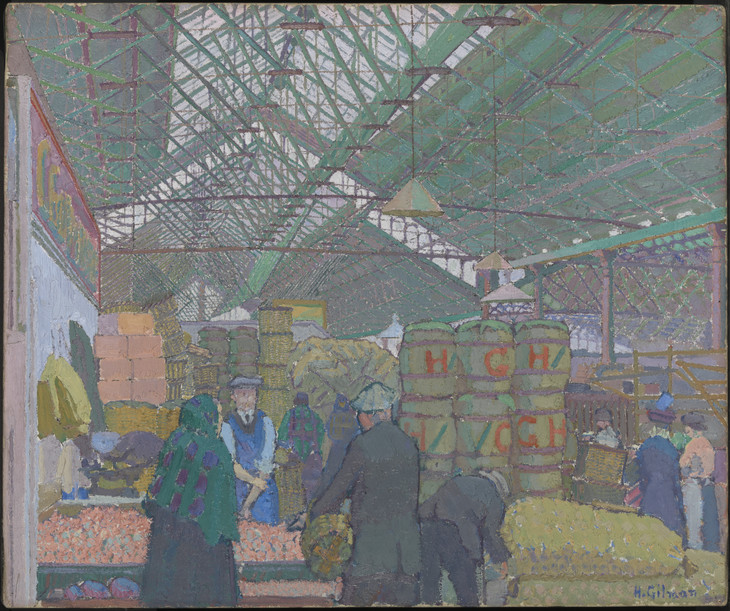
Harold Gilman 1876–1919
Leeds Market c.1913
Oil paint on canvas
support: 508 x 610 mm; frame: 690 x 790 x 75 mm
Tate N04273
Presented by the Very Rev. E. Milner-White 1927
Fig.1
Harold Gilman
Leeds Market c.1913
Tate N04273
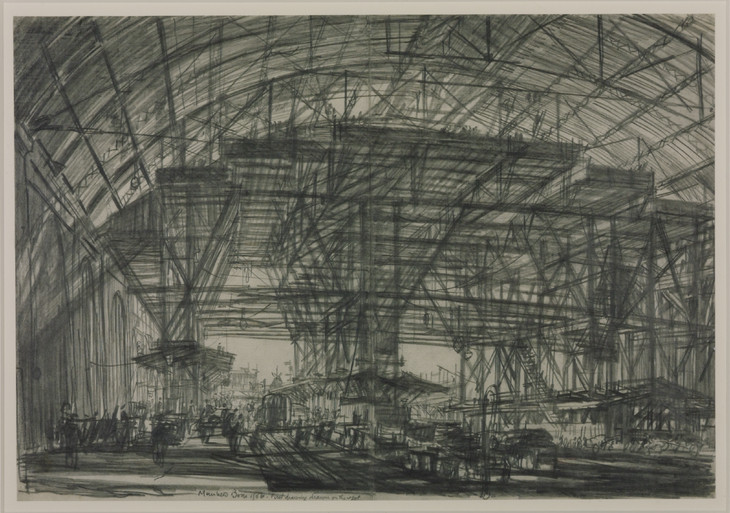
Sir Muirhead Bone 1876–1953
Study for `The Great Gantry, Charing Cross Station' 1906
Pencil and crayon on paper
support: 262 x 378 mm
Tate N02300
Presented by Miss Evelyn de Ponsonby McGhee 1908
© The estate of Sir Muirhead Bone
Fig.2
Sir Muirhead Bone
Study for `The Great Gantry, Charing Cross Station' 1906
Tate N02300
© The estate of Sir Muirhead Bone
The first owner of this drawing was Sir Louis Fergusson (1878–1962), who recalled in a letter to the Tate Gallery dated 1 June 1957:
My diary reminds me that on 10th March 1916 Gilman and I dined at the Sceptre in Warwick Street and then repaired to his lodgings in 47 Maple Street ‘for a very long chatter about art’. I already had a couple of his paintings and on this occasion persuaded him to let me have some drawings. He showed me scores of them and was most anxious for me to choose ones which he himself thought good. He distinctly told me that he had never yet drawn for exhibition or exhibited his drawings.1
Fergusson was a committed patron of the Camden Town Group, who also owned Spencer Gore’s Inez and Taki (see Tate N05859 for an account of Fergusson’s career). With Wyndham Lewis, Fergusson wrote Harold Gilman: An Appreciation, which appeared after Gilman’s death in 1919. ‘Gore introduced me to Gilman at 19 Fitzroy Street in December 1908’, Fergusson recalled, ‘on one of those delightful Saturday afternoons when you were free to feast your eyes on relay after relay of what were mostly little pictures for little patrons.’2
Robert Upstone
May 2009
Notes
Related biographies
Related essays
- Leisure Interiors in the Work of the Camden Town Group Jonathan Black, Fiona Fisher and Penny Sparke
- Walter Sickert’s Drawing Practice and the Camden Town Ethos Alistair Smith
- The Evolution of Painting Technique among Camden Town Group Artists Stephen Hackney
Related catalogue entries
Related reviews and articles
- Louis F. Fergusson, ‘Harold Gilman’ in Wyndham Lewis and Louis F. Fergusson, Harold Gilman: An Appreciation, London: Chatto & Windus 1919, pp.19–32.
Related film
-
Conservator Stephen Hackney on Harold Gilman's Leeds Market c.1913© 2011 Tate
How to cite
Robert Upstone, ‘Study for ‘Leeds Market’ c.1913 by Harold Gilman’, catalogue entry, May 2009, in Helena Bonett, Ysanne Holt, Jennifer Mundy (eds.), The Camden Town Group in Context, Tate Research Publication, May 2012, https://www

